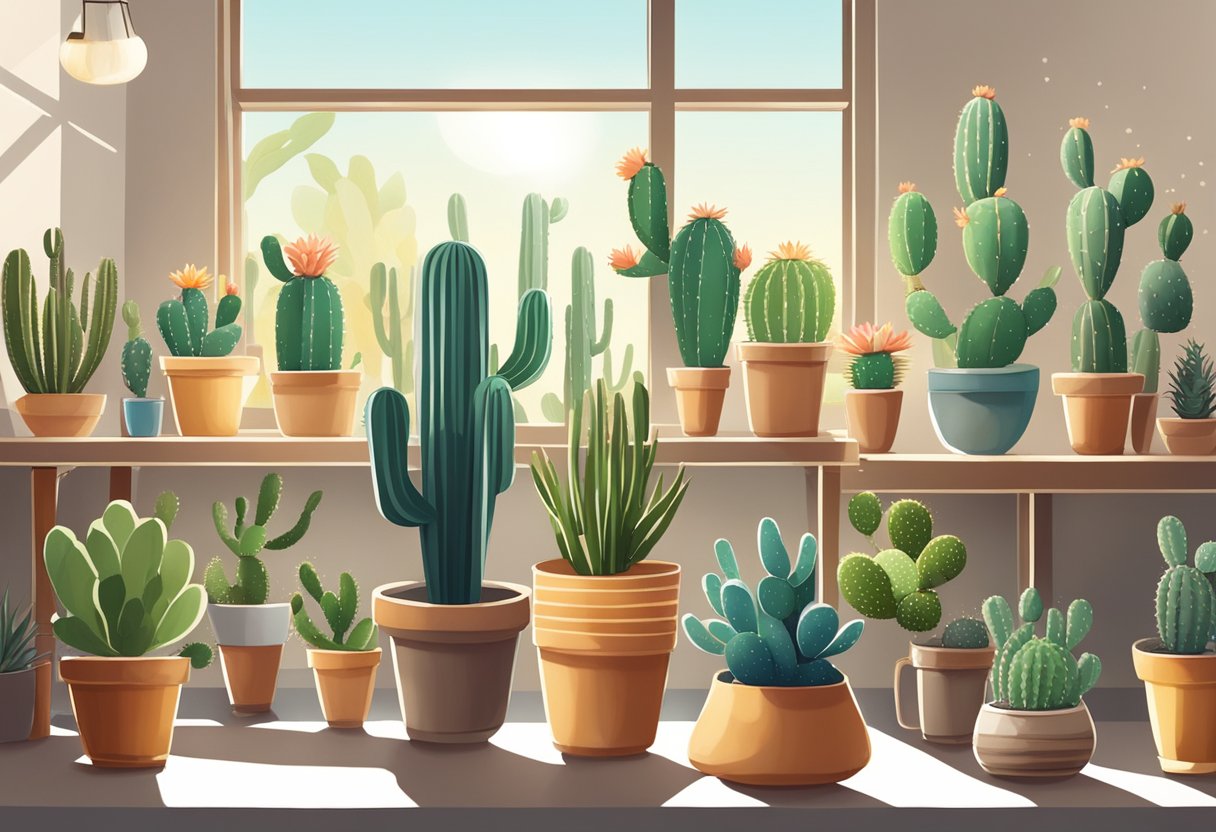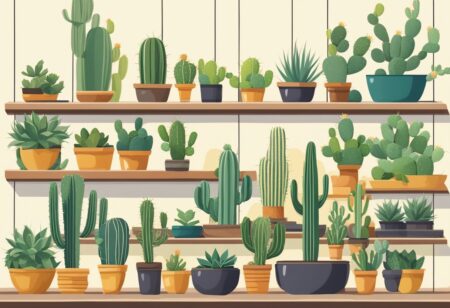A Guide to Choosing Your Ideal Succulent
Cacti have become a popular choice among houseplant enthusiasts due to their unique shapes, sizes, and low-maintenance requirements. These spiny plants are well-suited to indoor conditions, as they thrive in environments with direct sunlight and minimal water. With a wide range of species, each with its own distinct characteristics, indoor cacti can add a touch of desert elegance to any home.
When selecting a cactus for indoor cultivation, it’s important to consider the plant’s light and space needs, as well as its growth habits. Some cacti remain compact and are perfect for windowsills and desks, while others may grow taller and require more room. Indoor cacti such as the Christmas Cactus, the Star Cactus, and the Barrel Cactus each provide a different aesthetic appeal and fit various interior designs.
Caring for an indoor cactus involves understanding the balance between watering, lighting, and temperature. Overwatering is a common issue, so ensuring a proper drainage system and a watering schedule that mimics the plant’s natural arid habitat is crucial. These resilient houseplants offer a range of options for gardeners of all levels, introducing a sculptural and natural element to the indoor environment.
Understanding Cacti as Houseplants
Cacti have become popular choices as indoor plants due to their unique aesthetics and low maintenance requirements. They add a touch of nature’s resilience to indoor spaces.
Defining Cacti and Succulents
Cacti are a distinct subgroup of succulents, characterized by their capacity to store water in their stems, leaves, or roots. Succulents, on the other hand, encompass a broader range of plants, all sharing this water-storing capability. Most cacti exhibit spines, which are modified leaves designed to protect the plant and minimize water loss, and they typically thrive in dry environments.
Benefits of Indoor Cacti
Indoor cacti offer several advantages as houseplants:
- Air purification: They can help improve indoor air quality by removing toxins and releasing oxygen.
- Aesthetic value: Cacti provide an array of forms, sizes, and colors, contributing to diverse home decors.
- Therapeutic effects: The presence of plants like cacti indoors can reduce stress and enhance mood.
- Water efficiency: These plants require less watering compared to other indoor plants, making them suitable for busy individuals.
- Easy to care for: Cacti’s resilience makes them ideal for beginners or those with less time for plant maintenance.
By integrating cacti into home settings, individuals can enjoy the beauty and benefits of these hardy plants.
Popular Types of Indoor Cacti
Indoor cacti have become increasingly popular due to their striking forms and low maintenance needs. They are perfect for adding a touch of greenery to indoor spaces.
Christmas Cactus (Schlumbergera)
The Christmas cactus thrives in indirect light and requires more watering than others. It blooms in winter, bringing festive flowers in shades of pink, red, or purple.
Star Cactus (Astrophytum Ornatum)
Star cactus, known for its star-like shape, prefers bright light but minimal water. Its spherical form is dotted with white flecks and can produce yellow flowers.
Barrel Cactus (Echinocactus)
The barrel cactus is ideal for indoor growers, as it requires very little care. It has a ribbed, cylindrical shape and should be placed in a spot with direct sunlight.
Moon Cactus (Gymnocalycium Mihanovichii)
Moon cactus is a popular graft, recognizable by its vibrant top, which can be red, pink, yellow, or orange. It demands bright but indirect light.
Rat Tail Cactus (Aporocactus Flagelliformis)
The rat tail cactus sports long, trailing stems with fine spines, suitable for hanging baskets. It prefers bright light and enjoys periodic waterings.
Bishop’s Cap (Astrophytum Myriostigma)
Lastly, Bishop’s cap earns admiration for its unique, unspined globular shape that resembles a cleric’s hat. It flourishes under bright light but requires minimal watering.
Conditions for Indoor Cactus Growth

Growing cacti indoors requires attention to specific environmental factors to ensure their health and vigor. Proper lighting, soil composition, watering techniques, and temperature control are crucial for their success.
Light Requirements
Cacti demand ample lighting to thrive. They should be placed in a location where they can receive several hours of bright sunlight daily. A south-facing window is ideal for maximizing exposure to natural light. If natural light is insufficient, one can supplement with grow lights positioned 12-18 inches above the plants.
Soil and Potting
The soil for indoor cacti must provide excellent drainage. Well-draining soil mixes, specifically formulated for cacti, can prevent root rot. The pot should have drainage holes at the bottom, and adding a layer of gravel can further help with moisture management. Regular soil or potting mixes shouldn’t be used, as they retain too much moisture.
Watering Techniques
Cacti require a balanced watering approach. Water them thoroughly until excess water runs out of the pot’s drainage holes, then allow the soil to completely dry out before the next watering. This cycle mimics their natural arid conditions. Over-watering is a common mistake that can be detrimental to cactus health.
Temperature Regulation
Indoor cacti prefer temperatures between 70°F and 100°F during their growth period in the spring and summer. They benefit from cooler temperatures, around 50°F to 65°F, during the dormant winter period. Sudden temperature fluctuations should be avoided to prevent stress on the plants.
Caring for Your Indoor Cactus
Indoor cactus plants require specific care routines to thrive. They need the right balance of nutrients, environmental conditions, and maintenance to ensure successful growth and flowering.
Feeding and Fertilization
Cacti require less fertilizer compared to other houseplants. During the growing season, spring and summer, feed them with a cactus-specific fertilizer once a month. It should be dilute, roughly half the strength of what is recommended on the package. Avoid feeding during the dormant period in the winter months, as this can harm the plant.
Managing Humidity and Airflow
Cacti prefer a dry environment with low humidity levels. They generally thrive at around 40%-60% humidity, which is typical in most homes. Ensure there is good air circulation but avoid placing your cactus in the path of harsh drafts. An occasional misting can mimic natural aridity changes, but this should not be frequent.
Pruning and Maintenance
Pruning a cactus is mostly about removing dead or damaged spikes and should be done carefully using gloves or tweezers. If a cactus becomes too large, they may be gently trimmed back to shape. This helps the plant focus its nutrients on healthy growth. Regularly remove any debris from the topsoil to prevent pest infestations.
Handling Dormancy and Blooming
Cacti have a natural dormant period during the cooler months. They require less water, cooler temperatures, and no fertilizer during this time to rest. When conditions are favorable, cacti might produce a bloom. Adequate light and the return to a regular watering schedule after dormancy help encourage flowering. However, not all indoor cacti will bloom, as they require specific seasonal cues that can be difficult to replicate indoors.
Troubleshooting Common Issues
When caring for indoor cactus plants, one may encounter several issues ranging from pest infestations to water problems. This section will guide the reader through the essential steps to manage these common problems effectively.
Pest and Disease Management
Pests such as mealybugs and spider mites can be troublesome for cactus owners. To combat these pests, one should:
- Inspect plants regularly for signs of infestation.
- Use a soft cloth or soft-bristled brush to remove the pests.
- Apply insecticidal soap or neem oil as a natural treatment option.
For diseases like root rot, these measures are recommended:
- Ensure proper drainage to avoid water accumulation.
- Remove affected parts of the cactus to prevent spread.
- Sterilize tools after use to avoid contamination.
Dealing with Slow Growth
A cactus may exhibit slow growth due to several factors including inadequate lighting, poor soil conditions, or insufficient nutrients. Addressing these can stimulate better growth:
- Provide a minimum of four hours of sunlight daily.
- Use a well-draining soil mix specific to cacti and succulents.
- Fertilize sparingly, using a low-nitrogen, high-potassium fertilizer.
Addressing Water and Moisture Problems
Proper watering is critical for cactus health. Over-watering or under-watering can lead to various issues:
| Symptom | Likely Cause | Solution |
|---|---|---|
| Soft, yellowing stems | Over-watering | Allow soil to dry between waterings |
| Wrinkled, shriveled skin | Under-watering | Increase watering frequency gently |
| Black or brown spots on the base | Root rot due to excess moisture | Improve drainage and reduce water |
Humidity levels should be monitored, as cacti prefer dry air. If the air is too moist:
- Use a dehumidifier in the room.
- Avoid grouping plants too closely to allow for adequate air flow.
Repotting and Propagation
Successful cultivation of cacti indoors requires periodic repotting and propagation, allowing for healthy growth and the creation of new plants. These processes offer opportunities to refresh soil, increase pot size, and encourage robust development.
When and How to Repot
Repotting should occur every two to four years or when the cactus outgrows its container. Check roots annually for signs they have become pot-bound. The best time to repot is in the spring, when cacti begin their active growing period.
- Select a new pot slightly larger than the current one and ensure it has sufficient drainage holes.
- Prepare a suitable soil mix, generally a combination of potting soil and coarse sand or perlite for improved drainage.
- Carefully remove the plant from its current pot, gently shaking off any loose soil and untangling roots if necessary.
- Place the cactus in the new pot, centering it before backfilling with the fresh soil mix, and firming gently.
- Wait one week before watering to allow any damaged roots to heal.
Propagation Methods
Propagation allows gardeners to grow new plants from an existing cactus. Two principal methods are cuttings and seed sowing.
- Cuttings:
- Select a healthy segment of the cactus and use a clean, sharp knife to make a cutting.
- Let the cutting dry for a few days until a callus forms over the cut surface.
- Plant the cutting in a moist, well-draining soil mix, and keep it in bright, indirect light until roots develop.
- Seeds:
- Sow cactus seeds in a shallow tray filled with a fine, sandy soil mix and gently cover with a small layer of sand.
- Keep the soil moist and cover with a clear lid or plastic wrap to maintain humidity.
- Place the tray in a warm, bright location but out of direct sunlight until germination occurs, which can take weeks to months.
Selecting the Right Cactus for Your Space
Choosing the right cactus for indoor cultivation entails considering environmental conditions, growth size, and personal style. Each factor plays a crucial role in ensuring a healthy plant that fits seamlessly into one’s living space.
Assessing Your Environment
One must consider light, temperature, and humidity when selecting an indoor cactus. Cacti generally require bright, indirect sunlight and prefer temperatures between 60-80°F (15-27°C). Low humidity is ideal, as high moisture can lead to rot. A location near a south-facing window might be an optimal spot for a cactus to thrive, as they get ample sunlight without the harsh afternoon exposure.
Cactus Size and Growth Expectations
Before purchasing, it’s important to understand a cactus’s potential size and growth rate. Some species remain small, while others grow tall or wide.
| Cactus Type | Expected Size | Growth Rate |
|---|---|---|
| Mammillaria | 6-12 inches | Slow |
| Opuntia | 3-6 feet | Moderate |
| Echinocactus | Up to 10 feet | Slow |
One should allocate space accordingly for the cactus to grow without restraint and consider a species with a growth rate that they can manage.
Aesthetic Considerations
Finally, the visual aspect of the cactus should complement the decor of the room. Consider shape, color, and texture:
- Shapes: Spherical, columnar, or sprawling
- Colors: Shades of green, blue, purple, or even red
- Textures: Smooth, ribbed, or spiny
One might choose a cactus that provides a striking focal point or a more subdued plant that enhances the overall aesthetics. A collection of small cacti in uniform pots creates a cohesive look, while varied pots add eclectic charm.
Frequently Asked Questions
This section provides clear and concise answers to commonly asked questions regarding the selection and maintenance of indoor cactus plants.
What are some common types of cacti suitable for indoor environments?
Common indoor cacti include the Christmas Cactus (Schlumbergera), the Star Cactus (Astrophytum), and the Bunny Ears Cactus (Opuntia microdasys). These species are well-adapted to indoor conditions and can thrive with proper care.
How can I identify the different species of cacti I own?
Identification can be made by examining characteristics such as the shape of the cactus, spine structure, flowers, and growth habits. Reference books or online databases on cacti can provide visual comparisons and detailed descriptions.
Which varieties of cactus plants are best suited for placement in a bedroom?
The Zebra Cactus (Haworthia fasciata) and the Moon Cactus (Gymnocalycium mihanovichii) are among the best choices for bedroom environments due to their moderate size and low light requirements.
What is the easiest variety of cactus to care for indoors?
The Prickly Pear (Opuntia) is one of the easiest cacti to care for indoors, as it is forgiving and adaptable to various indoor conditions. It requires minimal watering and can handle less direct sunlight than some other cacti.
Can you provide images to help differentiate between various indoor cactus species?
Images are a valuable tool for distinguishing between cacti species. However, this section does not contain images. Readers are encouraged to consult online resources or cactus identification books where images and specific details can be found.
What are some tips for positioning a cactus within my home for optimal growth?
Place cacti in well-lit areas, avoiding direct sunlight that may scorch them. Ensure the pot has proper drainage and use soil specifically designed for cacti. Keep the plants away from drafts and rotate them periodically to ensure even growth.




